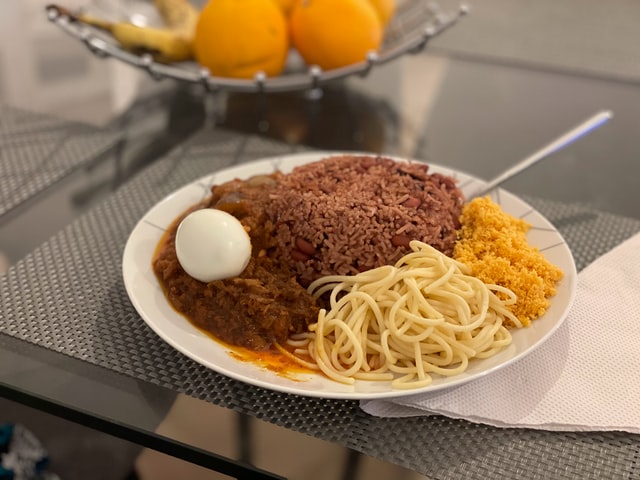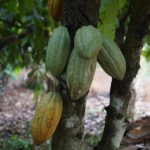Flavors of the Volta: An Intro to Ghanaian Food

Ghana is a fantastic place with a sad history; just consult any school history textbook to learn about the horrific Atlantic slave trade. Yet even within Ghana, the colonial history is divided. I spent several months in a small town in the Volta Region of eastern Ghana, which was once a part of German Togoland while the remainder of Ghana was under British control. Today, commonalities with the rest of the country outweigh differences in the Volta Region, and a visit to the beautiful hills is certainly worthwhile, especially to enjoy Ghanaian food.
Generally speaking, Ghanaians love to party. Singing and dancing is a staple of any of the frequent social gatherings, and the deafeningly loud music announces the festivities to the entire neighborhood. Colorful printed fabrics liven up the atmosphere (and many have significant symbolism). But most importantly, Ghanaians bond over their delicious food.
And rightly so. Practically located at the intersection of the Equator and Prime Meridian, Ghana is a tropical paradise of fruits and vegetables, and something delicious is always in season. West Africans have capitalized on their bountiful harvests to produce truly excellent foods, even some specific only to the Volta Region!
In the capital city of Ho, my former hometown, one can wander the labyrinthine stalls of the daily market to find fruits and vegetables of many kinds, but also giant land snails, fresh palm oil, and a number of fried dough varieties. The market doesn’t typically open until 7am and closes around sunset, but vendors line the streets at almost all hours to settle any urgent cravings. Prices are fairly standard, and most items are sold according to bulk rules—fixed price for a certain amount—so buyers state prices rather than numbers of items.
Preparing Ghanaian food at home is not the easiest for first-attempters, particularly if traveling as some dishes can take serious preparation time. To sample a broad variety of dishes, swing by a street vendor with lidded pots on display, a chop bar—a quick meal kiosk, or an established restaurant. They all offer roughly the same things, and you’ll quickly discover what is and is not good quality. Here are some dishes you may encounter:
Flavors of the Volta: An Intro to Ghanaian Food
Banku
West African meals are all rather similar—a starchy dumpling type ball served with meat- or fish-based stew. Some dish names may already be familiar. Fufu goes by many names and is essentially a ball of boiled cassava, plantain, or yam flour. Similarly, kenkey [ken-kay] is boiled and fermented maize meal. The people of Volta, however, prefer banku [ban-koo] or akple [ah’-play], a ball of boiled and fermented maize and cassava flours. None of these will likely make the next cover of Saveur magazine, but their purpose is secondary to the incredibly flavorful soups and stews with which they are paired. Be mindful, though, that Ghanaian dishes are incredibly spicy due to the liberal use of small but potent hot peppers!
Waakye
An alternative to the starchy dumplings is waakye [wah-chay]—a fried rice and bean base that can be served with meat, fish, eggs, salad, noodles, spicy sauces, mild sauces, you name it! It is a popular breakfast dish, so stalls tend to run out of waakye by early afternoon. Arrive early!
Koko
Early morning breakfast is a simple affair—often only fruit or tea—but that doesn’t stop vendors from selling the best porridges money can buy each morning. Koko can be made from maize, millet, rice, or any other grain, boiled to a moderately thick grainy liquid. The texture varies with preparation method, and one style even contains whole maize kernels. Koko can be sweet, but the true experience is a bowl of spicy Hausa koko that boasts a unique flavor with a kick. Koko is often served with a side of koose [koo-see], fried bean fritters and/or roasted groundnuts.
Red-red
My favorite dish is a bean stew called ‘red-red,’ so named for its red color derived from the red of the palm oil used to prepare the beans and fry the accompanying plantains – charmingly named kelewele. If you have good red-red, you’ll never want to eat anything else! From my experience, this dish is best obtained at a restaurant.
To do justice to the sheer variety of Ghanaian cuisine would require more words and time than I have to write and readers have to spare, but know that a culinary cornucopia awaits the curious intrepid explorer.
Parting tips:
If you’re coming from outside Acra, you will likely arrive by minibus taxi (here called tro-tros) or large bus. Regardless of mode of transport, at every stop there will be vendors clamoring to sell foods and trinkets through the vehicle windows. Choose from hardboiled eggs served with spicy pepper slaw, fried dough balls, fresh fruits and more!
The currency in Ghana is the Ghana cedi, pronounced see-dee, and one cedi is subdivided into 100 peswas. Market produce prices tend to hover between 1 and 5 cedi, and meat and fish cost a bit more, in the 10-20 cedi range. Chop bars are often cheaper than restaurants, but don’t always provide places to sit since they are intended as takeaways. But no matter what your budget, where you choose to eat, or which foods you decide to try, Ghanaian food serves the same purpose for visitors and locals alike.
Come hungry. Leave happy!
Ghanaian Food: Flavors of the Volta, An Intro to Ghanaian Food photo credits by Unsplash and Becky Dale.









